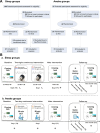Efficacy and mechanisms of repeated closed-loop auditory exposure during slow-wave sleep for internet gaming disorder
- PMID: 40425853
- PMCID: PMC12339371
- DOI: 10.1038/s41380-025-02995-1
Efficacy and mechanisms of repeated closed-loop auditory exposure during slow-wave sleep for internet gaming disorder
Abstract
Internet Gaming Disorder (IGD) is marked by impaired psychological and social functioning but remains without effective treatments. Cue exposure therapy (CET) is typically administered during wakefulness to help extinguish addictive memories. However, recent studies suggest that sleep may be an optimal state for memory modulation. This study aimed to assess the efficacy of repeated closed-loop exposure to game sounds during UP-state of slow-wave sleep (SWS) on IGD. 84 participants meeting DSM-5 criteria for IGD were randomly assigned to sleep intervention/control groups (SIG/SCG) or awake intervention/control groups (AIG/ACG) with two consecutive days of intervention. During SWS of two intervention nights, around 300 sounds were exposed at slow-wave UP-state. While the awake groups received similar auditory cue exposure during the awake state for two consecutive days. Cravings, playtime, and P300 amplitude in the cue reactivity task were recorded at baseline, post-intervention, and follow-up intervals (1, 2, 3, weeks, and 1 month). Results showed that the SIG significantly reduced cravings (p < 0.001), and playtime (p = 0.009) at post-intervention and follow-up, whereas awake CET showed no effect. The SIG exhibited higher low-frequency and early spindle power, along with lower late spindle power after sound exposure. Notably, the linear increase in sound-elicited late spindle power across the 20 intervention blocks over two experiment nights was positively correlated with reduced cravings post-intervention (r = 0.54, p = 0.015), especially among participants achieving a craving reduction greater than 30% after one month. Our findings suggest that closed-loop auditory exposure during SWS presents a promising, non-invasive intervention strategy for treating IGD, potentially exerting its effects by modulating late spindle power.
© 2025. The Author(s).
Conflict of interest statement
Competing interests: The authors declare no competing interests.
Figures




Similar articles
-
Sleep Quality as a Mediator of Internet Gaming Disorder and Executive Dysfunction in Adolescents: Cross-Sectional Questionnaire Study.J Med Internet Res. 2025 Jul 9;27:e68571. doi: 10.2196/68571. J Med Internet Res. 2025. PMID: 40632805 Free PMC article.
-
Increasingly dependent on habit? A study on the electrophysiological mechanisms of goal-directed and habitual control in internet gaming disorder.J Behav Addict. 2025 May 15;14(2):757-775. doi: 10.1556/2006.2024.00084. Print 2025 Jul 2. J Behav Addict. 2025. PMID: 40372798 Free PMC article.
-
Longitudinal Network Relationships Between Symptoms of Deviant Peer Affiliation and Internet Gaming Disorder in Adolescents: Prospective Cohort Study.J Med Internet Res. 2025 Jun 13;27:e72543. doi: 10.2196/72543. J Med Internet Res. 2025. PMID: 40513001 Free PMC article.
-
The Black Book of Psychotropic Dosing and Monitoring.Psychopharmacol Bull. 2024 Jul 8;54(3):8-59. Psychopharmacol Bull. 2024. PMID: 38993656 Free PMC article. Review.
-
Technological aids for the rehabilitation of memory and executive functioning in children and adolescents with acquired brain injury.Cochrane Database Syst Rev. 2016 Jul 1;7(7):CD011020. doi: 10.1002/14651858.CD011020.pub2. Cochrane Database Syst Rev. 2016. PMID: 27364851 Free PMC article.
Cited by
-
Compositional and functional gut microbiota alterations in mild cognitive impairment: links to Alzheimer's disease pathology.Alzheimers Res Ther. 2025 May 30;17(1):122. doi: 10.1186/s13195-025-01769-9. Alzheimers Res Ther. 2025. PMID: 40448221 Free PMC article.
References
-
- Petry NM, Rehbein F, Gentile DA, Lemmens JS, Rumpf HJ, Mößle T, et al. An international consensus for assessing internet gaming disorder using the new DSM-5 approach. Addiction. 2014;109:1399–406. 10.1111/add.12457 - PubMed
-
- American Psychiatric Association, DSM-5 Task Force. (2013). Diagnostic and statistical manual of mental disorders: DSM-5™ (5th ed.). American Psychiatric Publishing, Inc. 10.1176/appi.books.9780890425596
-
- Gao YX, Wang JY, Dong GH. The prevalence and possible risk factors of internet gaming disorder among adolescents and young adults: systematic reviews and meta-analyses. J Psychiatr Res. 2022;154:35–43. 10.1016/j.jpsychires.2022.06.049 - PubMed
-
- Hyman SE. Addiction: a disease of learning and memory. Am J Psychiatry. 2005;162:1414–22. 10.1176/appi.ajp.162.8.1414 - PubMed
Publication types
MeSH terms
Grants and funding
LinkOut - more resources
Full Text Sources
Miscellaneous

